4000ENG/7001ENG: Road Materials, Pavement Design and Research Plan
VerifiedAdded on 2023/06/03
|23
|4960
|100
Report
AI Summary
This report provides a comprehensive analysis of road materials and pavement design, focusing on the classification of pavement stabilized materials, including sub-grade stabilization, in-situ stabilization, and plant mix stabilization. It discusses the importance of aggregate mixtures with minimal voids for maximum compaction and impermeability. The report explores different pavement layer formations based on material properties and load applications, emphasizing the design criteria for mechanically stabilized pavements and those modified with higher content binder materials. It also examines the binding process, utilizing materials like lime, slag, and cement, and the selection of appropriate binders based on the base material. The application of coal combustion products (CCPs) such as fly ash and furnace bottom ash in pavement stabilization is discussed, along with the impact of traffic loads and axle configurations on pavement deterioration. Finally, the report highlights the significance of sub-base and subgrade characteristics in pavement performance and structural integrity. The Australian Standard (AS) 3582.1 requirements for fly ash are also considered in the process of selecting suitable materials used in stabilizations work.
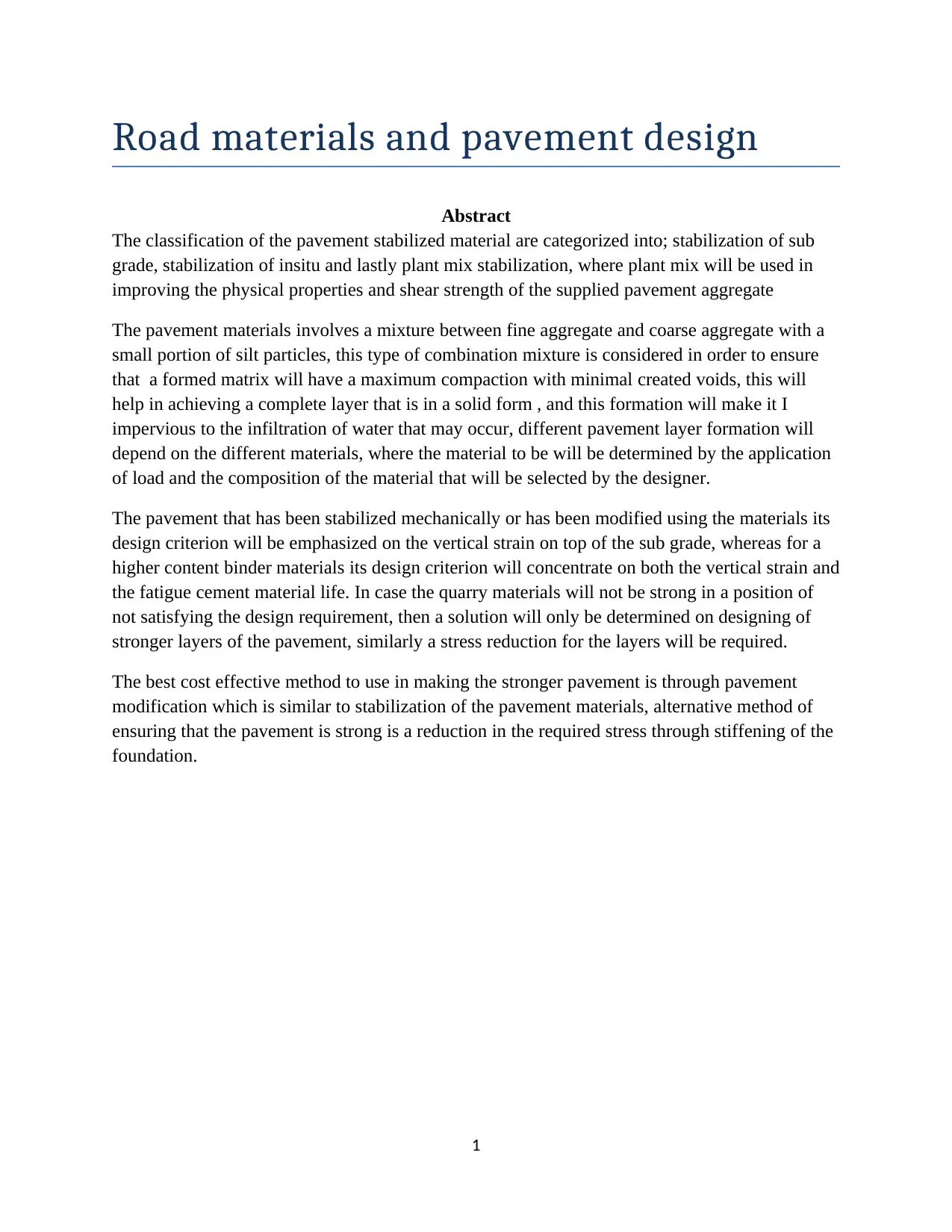
Road materials and pavement design
Abstract
The classification of the pavement stabilized material are categorized into; stabilization of sub
grade, stabilization of insitu and lastly plant mix stabilization, where plant mix will be used in
improving the physical properties and shear strength of the supplied pavement aggregate
The pavement materials involves a mixture between fine aggregate and coarse aggregate with a
small portion of silt particles, this type of combination mixture is considered in order to ensure
that a formed matrix will have a maximum compaction with minimal created voids, this will
help in achieving a complete layer that is in a solid form , and this formation will make it I
impervious to the infiltration of water that may occur, different pavement layer formation will
depend on the different materials, where the material to be will be determined by the application
of load and the composition of the material that will be selected by the designer.
The pavement that has been stabilized mechanically or has been modified using the materials its
design criterion will be emphasized on the vertical strain on top of the sub grade, whereas for a
higher content binder materials its design criterion will concentrate on both the vertical strain and
the fatigue cement material life. In case the quarry materials will not be strong in a position of
not satisfying the design requirement, then a solution will only be determined on designing of
stronger layers of the pavement, similarly a stress reduction for the layers will be required.
The best cost effective method to use in making the stronger pavement is through pavement
modification which is similar to stabilization of the pavement materials, alternative method of
ensuring that the pavement is strong is a reduction in the required stress through stiffening of the
foundation.
1
Abstract
The classification of the pavement stabilized material are categorized into; stabilization of sub
grade, stabilization of insitu and lastly plant mix stabilization, where plant mix will be used in
improving the physical properties and shear strength of the supplied pavement aggregate
The pavement materials involves a mixture between fine aggregate and coarse aggregate with a
small portion of silt particles, this type of combination mixture is considered in order to ensure
that a formed matrix will have a maximum compaction with minimal created voids, this will
help in achieving a complete layer that is in a solid form , and this formation will make it I
impervious to the infiltration of water that may occur, different pavement layer formation will
depend on the different materials, where the material to be will be determined by the application
of load and the composition of the material that will be selected by the designer.
The pavement that has been stabilized mechanically or has been modified using the materials its
design criterion will be emphasized on the vertical strain on top of the sub grade, whereas for a
higher content binder materials its design criterion will concentrate on both the vertical strain and
the fatigue cement material life. In case the quarry materials will not be strong in a position of
not satisfying the design requirement, then a solution will only be determined on designing of
stronger layers of the pavement, similarly a stress reduction for the layers will be required.
The best cost effective method to use in making the stronger pavement is through pavement
modification which is similar to stabilization of the pavement materials, alternative method of
ensuring that the pavement is strong is a reduction in the required stress through stiffening of the
foundation.
1
Paraphrase This Document
Need a fresh take? Get an instant paraphrase of this document with our AI Paraphraser
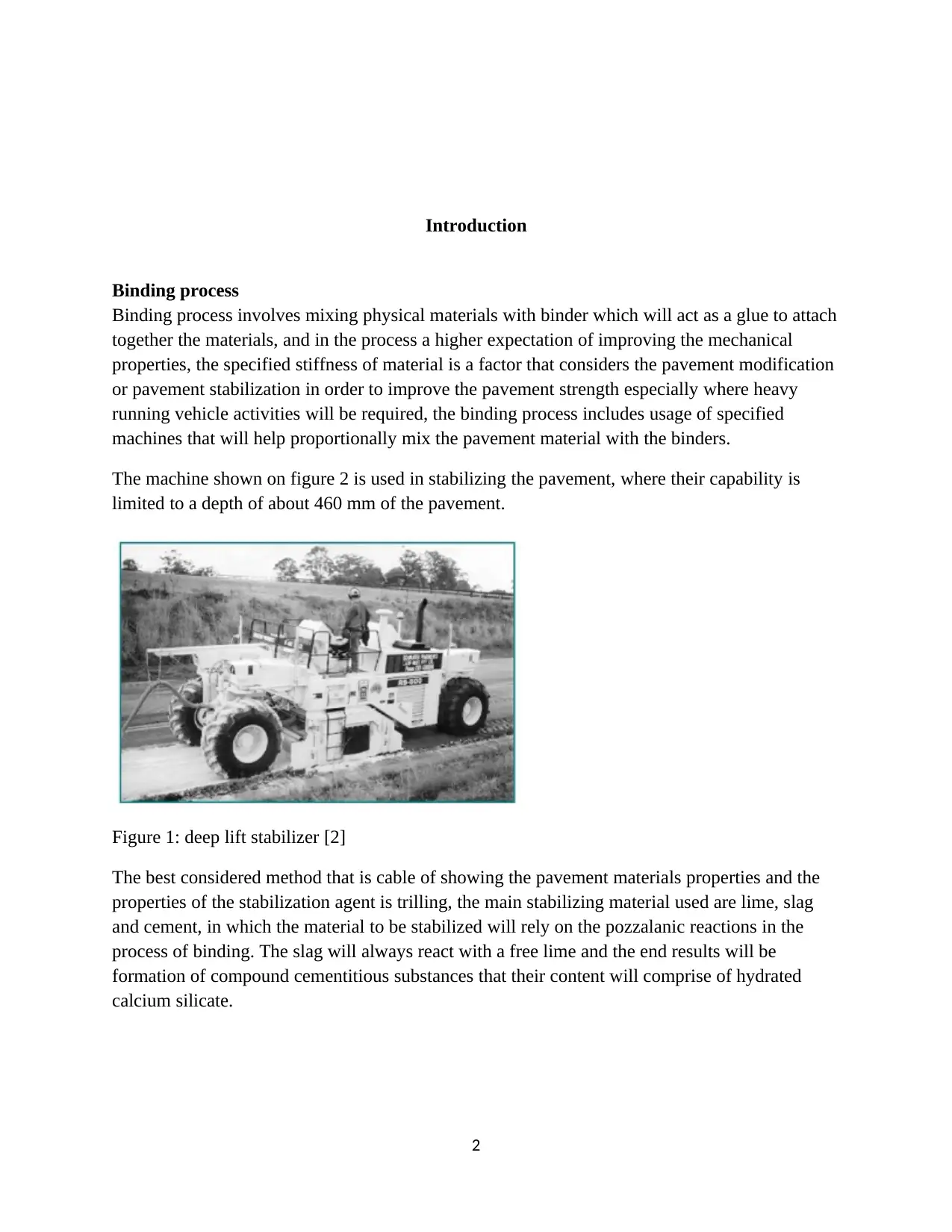
Introduction
Binding process
Binding process involves mixing physical materials with binder which will act as a glue to attach
together the materials, and in the process a higher expectation of improving the mechanical
properties, the specified stiffness of material is a factor that considers the pavement modification
or pavement stabilization in order to improve the pavement strength especially where heavy
running vehicle activities will be required, the binding process includes usage of specified
machines that will help proportionally mix the pavement material with the binders.
The machine shown on figure 2 is used in stabilizing the pavement, where their capability is
limited to a depth of about 460 mm of the pavement.
Figure 1: deep lift stabilizer [2]
The best considered method that is cable of showing the pavement materials properties and the
properties of the stabilization agent is trilling, the main stabilizing material used are lime, slag
and cement, in which the material to be stabilized will rely on the pozzalanic reactions in the
process of binding. The slag will always react with a free lime and the end results will be
formation of compound cementitious substances that their content will comprise of hydrated
calcium silicate.
2
Binding process
Binding process involves mixing physical materials with binder which will act as a glue to attach
together the materials, and in the process a higher expectation of improving the mechanical
properties, the specified stiffness of material is a factor that considers the pavement modification
or pavement stabilization in order to improve the pavement strength especially where heavy
running vehicle activities will be required, the binding process includes usage of specified
machines that will help proportionally mix the pavement material with the binders.
The machine shown on figure 2 is used in stabilizing the pavement, where their capability is
limited to a depth of about 460 mm of the pavement.
Figure 1: deep lift stabilizer [2]
The best considered method that is cable of showing the pavement materials properties and the
properties of the stabilization agent is trilling, the main stabilizing material used are lime, slag
and cement, in which the material to be stabilized will rely on the pozzalanic reactions in the
process of binding. The slag will always react with a free lime and the end results will be
formation of compound cementitious substances that their content will comprise of hydrated
calcium silicate.
2
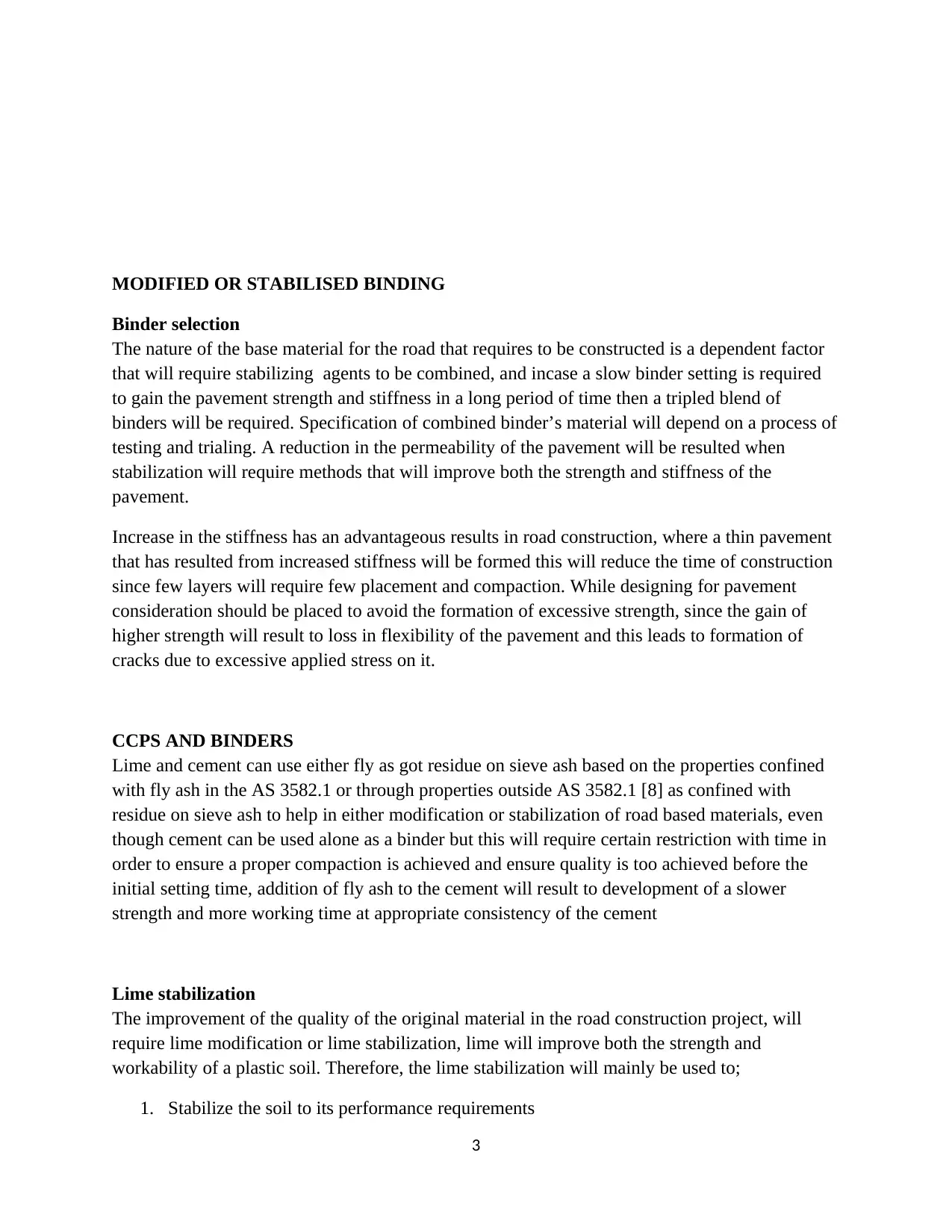
MODIFIED OR STABILISED BINDING
Binder selection
The nature of the base material for the road that requires to be constructed is a dependent factor
that will require stabilizing agents to be combined, and incase a slow binder setting is required
to gain the pavement strength and stiffness in a long period of time then a tripled blend of
binders will be required. Specification of combined binder’s material will depend on a process of
testing and trialing. A reduction in the permeability of the pavement will be resulted when
stabilization will require methods that will improve both the strength and stiffness of the
pavement.
Increase in the stiffness has an advantageous results in road construction, where a thin pavement
that has resulted from increased stiffness will be formed this will reduce the time of construction
since few layers will require few placement and compaction. While designing for pavement
consideration should be placed to avoid the formation of excessive strength, since the gain of
higher strength will result to loss in flexibility of the pavement and this leads to formation of
cracks due to excessive applied stress on it.
CCPS AND BINDERS
Lime and cement can use either fly as got residue on sieve ash based on the properties confined
with fly ash in the AS 3582.1 or through properties outside AS 3582.1 [8] as confined with
residue on sieve ash to help in either modification or stabilization of road based materials, even
though cement can be used alone as a binder but this will require certain restriction with time in
order to ensure a proper compaction is achieved and ensure quality is too achieved before the
initial setting time, addition of fly ash to the cement will result to development of a slower
strength and more working time at appropriate consistency of the cement
Lime stabilization
The improvement of the quality of the original material in the road construction project, will
require lime modification or lime stabilization, lime will improve both the strength and
workability of a plastic soil. Therefore, the lime stabilization will mainly be used to;
1. Stabilize the soil to its performance requirements
3
Binder selection
The nature of the base material for the road that requires to be constructed is a dependent factor
that will require stabilizing agents to be combined, and incase a slow binder setting is required
to gain the pavement strength and stiffness in a long period of time then a tripled blend of
binders will be required. Specification of combined binder’s material will depend on a process of
testing and trialing. A reduction in the permeability of the pavement will be resulted when
stabilization will require methods that will improve both the strength and stiffness of the
pavement.
Increase in the stiffness has an advantageous results in road construction, where a thin pavement
that has resulted from increased stiffness will be formed this will reduce the time of construction
since few layers will require few placement and compaction. While designing for pavement
consideration should be placed to avoid the formation of excessive strength, since the gain of
higher strength will result to loss in flexibility of the pavement and this leads to formation of
cracks due to excessive applied stress on it.
CCPS AND BINDERS
Lime and cement can use either fly as got residue on sieve ash based on the properties confined
with fly ash in the AS 3582.1 or through properties outside AS 3582.1 [8] as confined with
residue on sieve ash to help in either modification or stabilization of road based materials, even
though cement can be used alone as a binder but this will require certain restriction with time in
order to ensure a proper compaction is achieved and ensure quality is too achieved before the
initial setting time, addition of fly ash to the cement will result to development of a slower
strength and more working time at appropriate consistency of the cement
Lime stabilization
The improvement of the quality of the original material in the road construction project, will
require lime modification or lime stabilization, lime will improve both the strength and
workability of a plastic soil. Therefore, the lime stabilization will mainly be used to;
1. Stabilize the soil to its performance requirements
3
⊘ This is a preview!⊘
Do you want full access?
Subscribe today to unlock all pages.

Trusted by 1+ million students worldwide
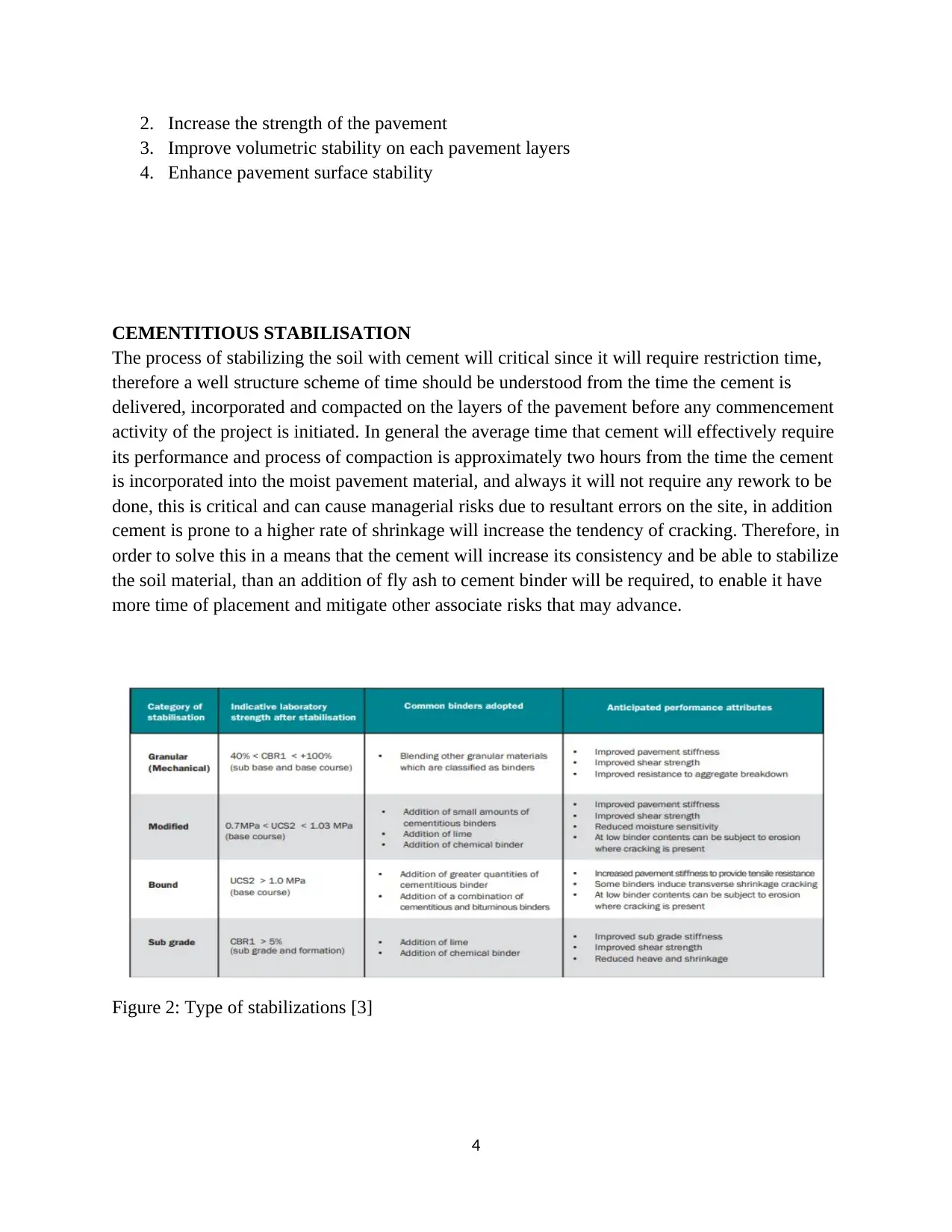
2. Increase the strength of the pavement
3. Improve volumetric stability on each pavement layers
4. Enhance pavement surface stability
CEMENTITIOUS STABILISATION
The process of stabilizing the soil with cement will critical since it will require restriction time,
therefore a well structure scheme of time should be understood from the time the cement is
delivered, incorporated and compacted on the layers of the pavement before any commencement
activity of the project is initiated. In general the average time that cement will effectively require
its performance and process of compaction is approximately two hours from the time the cement
is incorporated into the moist pavement material, and always it will not require any rework to be
done, this is critical and can cause managerial risks due to resultant errors on the site, in addition
cement is prone to a higher rate of shrinkage will increase the tendency of cracking. Therefore, in
order to solve this in a means that the cement will increase its consistency and be able to stabilize
the soil material, than an addition of fly ash to cement binder will be required, to enable it have
more time of placement and mitigate other associate risks that may advance.
Figure 2: Type of stabilizations [3]
4
3. Improve volumetric stability on each pavement layers
4. Enhance pavement surface stability
CEMENTITIOUS STABILISATION
The process of stabilizing the soil with cement will critical since it will require restriction time,
therefore a well structure scheme of time should be understood from the time the cement is
delivered, incorporated and compacted on the layers of the pavement before any commencement
activity of the project is initiated. In general the average time that cement will effectively require
its performance and process of compaction is approximately two hours from the time the cement
is incorporated into the moist pavement material, and always it will not require any rework to be
done, this is critical and can cause managerial risks due to resultant errors on the site, in addition
cement is prone to a higher rate of shrinkage will increase the tendency of cracking. Therefore, in
order to solve this in a means that the cement will increase its consistency and be able to stabilize
the soil material, than an addition of fly ash to cement binder will be required, to enable it have
more time of placement and mitigate other associate risks that may advance.
Figure 2: Type of stabilizations [3]
4
Paraphrase This Document
Need a fresh take? Get an instant paraphrase of this document with our AI Paraphraser
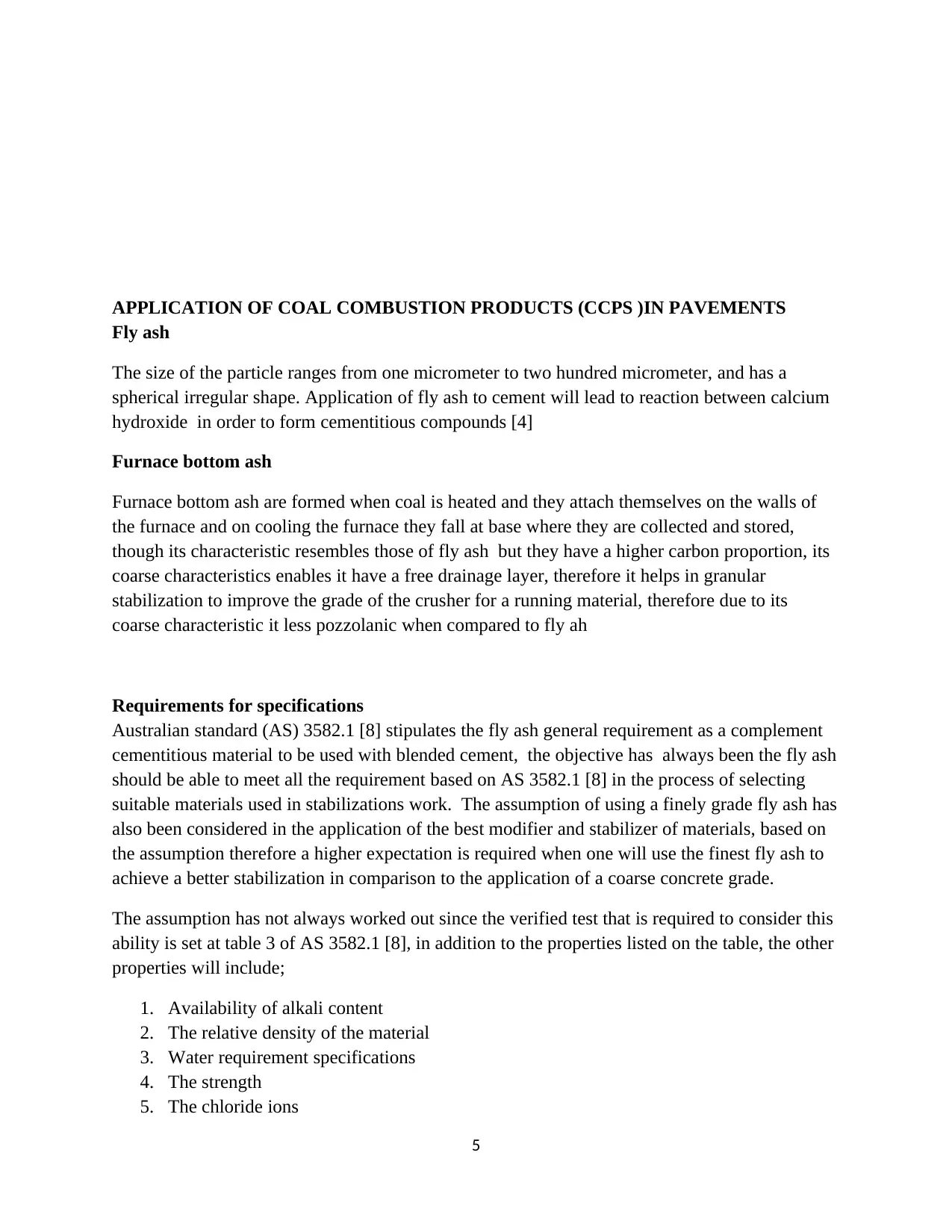
APPLICATION OF COAL COMBUSTION PRODUCTS (CCPS )IN PAVEMENTS
Fly ash
The size of the particle ranges from one micrometer to two hundred micrometer, and has a
spherical irregular shape. Application of fly ash to cement will lead to reaction between calcium
hydroxide in order to form cementitious compounds [4]
Furnace bottom ash
Furnace bottom ash are formed when coal is heated and they attach themselves on the walls of
the furnace and on cooling the furnace they fall at base where they are collected and stored,
though its characteristic resembles those of fly ash but they have a higher carbon proportion, its
coarse characteristics enables it have a free drainage layer, therefore it helps in granular
stabilization to improve the grade of the crusher for a running material, therefore due to its
coarse characteristic it less pozzolanic when compared to fly ah
Requirements for specifications
Australian standard (AS) 3582.1 [8] stipulates the fly ash general requirement as a complement
cementitious material to be used with blended cement, the objective has always been the fly ash
should be able to meet all the requirement based on AS 3582.1 [8] in the process of selecting
suitable materials used in stabilizations work. The assumption of using a finely grade fly ash has
also been considered in the application of the best modifier and stabilizer of materials, based on
the assumption therefore a higher expectation is required when one will use the finest fly ash to
achieve a better stabilization in comparison to the application of a coarse concrete grade.
The assumption has not always worked out since the verified test that is required to consider this
ability is set at table 3 of AS 3582.1 [8], in addition to the properties listed on the table, the other
properties will include;
1. Availability of alkali content
2. The relative density of the material
3. Water requirement specifications
4. The strength
5. The chloride ions
5
Fly ash
The size of the particle ranges from one micrometer to two hundred micrometer, and has a
spherical irregular shape. Application of fly ash to cement will lead to reaction between calcium
hydroxide in order to form cementitious compounds [4]
Furnace bottom ash
Furnace bottom ash are formed when coal is heated and they attach themselves on the walls of
the furnace and on cooling the furnace they fall at base where they are collected and stored,
though its characteristic resembles those of fly ash but they have a higher carbon proportion, its
coarse characteristics enables it have a free drainage layer, therefore it helps in granular
stabilization to improve the grade of the crusher for a running material, therefore due to its
coarse characteristic it less pozzolanic when compared to fly ah
Requirements for specifications
Australian standard (AS) 3582.1 [8] stipulates the fly ash general requirement as a complement
cementitious material to be used with blended cement, the objective has always been the fly ash
should be able to meet all the requirement based on AS 3582.1 [8] in the process of selecting
suitable materials used in stabilizations work. The assumption of using a finely grade fly ash has
also been considered in the application of the best modifier and stabilizer of materials, based on
the assumption therefore a higher expectation is required when one will use the finest fly ash to
achieve a better stabilization in comparison to the application of a coarse concrete grade.
The assumption has not always worked out since the verified test that is required to consider this
ability is set at table 3 of AS 3582.1 [8], in addition to the properties listed on the table, the other
properties will include;
1. Availability of alkali content
2. The relative density of the material
3. Water requirement specifications
4. The strength
5. The chloride ions
5
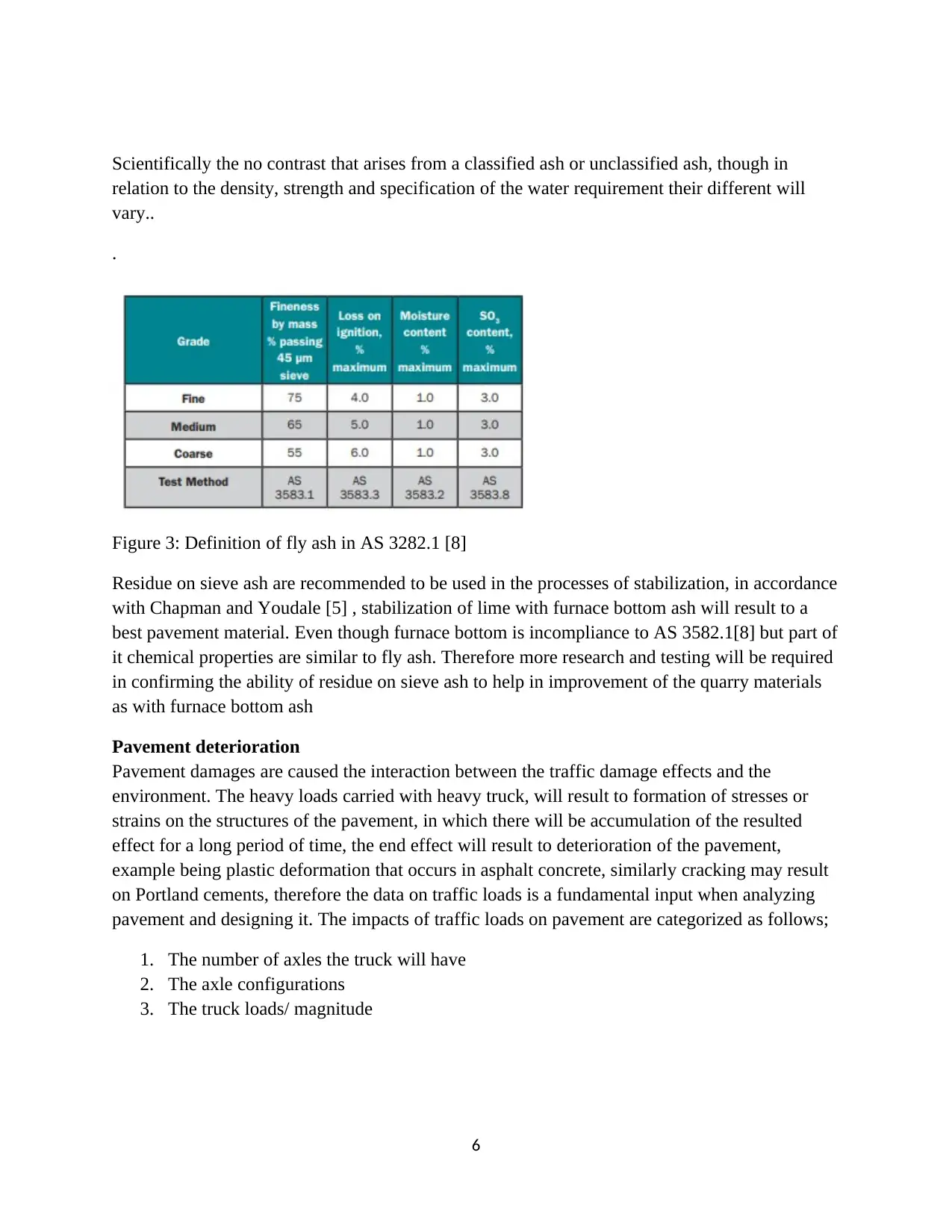
Scientifically the no contrast that arises from a classified ash or unclassified ash, though in
relation to the density, strength and specification of the water requirement their different will
vary..
.
Figure 3: Definition of fly ash in AS 3282.1 [8]
Residue on sieve ash are recommended to be used in the processes of stabilization, in accordance
with Chapman and Youdale [5] , stabilization of lime with furnace bottom ash will result to a
best pavement material. Even though furnace bottom is incompliance to AS 3582.1[8] but part of
it chemical properties are similar to fly ash. Therefore more research and testing will be required
in confirming the ability of residue on sieve ash to help in improvement of the quarry materials
as with furnace bottom ash
Pavement deterioration
Pavement damages are caused the interaction between the traffic damage effects and the
environment. The heavy loads carried with heavy truck, will result to formation of stresses or
strains on the structures of the pavement, in which there will be accumulation of the resulted
effect for a long period of time, the end effect will result to deterioration of the pavement,
example being plastic deformation that occurs in asphalt concrete, similarly cracking may result
on Portland cements, therefore the data on traffic loads is a fundamental input when analyzing
pavement and designing it. The impacts of traffic loads on pavement are categorized as follows;
1. The number of axles the truck will have
2. The axle configurations
3. The truck loads/ magnitude
6
relation to the density, strength and specification of the water requirement their different will
vary..
.
Figure 3: Definition of fly ash in AS 3282.1 [8]
Residue on sieve ash are recommended to be used in the processes of stabilization, in accordance
with Chapman and Youdale [5] , stabilization of lime with furnace bottom ash will result to a
best pavement material. Even though furnace bottom is incompliance to AS 3582.1[8] but part of
it chemical properties are similar to fly ash. Therefore more research and testing will be required
in confirming the ability of residue on sieve ash to help in improvement of the quarry materials
as with furnace bottom ash
Pavement deterioration
Pavement damages are caused the interaction between the traffic damage effects and the
environment. The heavy loads carried with heavy truck, will result to formation of stresses or
strains on the structures of the pavement, in which there will be accumulation of the resulted
effect for a long period of time, the end effect will result to deterioration of the pavement,
example being plastic deformation that occurs in asphalt concrete, similarly cracking may result
on Portland cements, therefore the data on traffic loads is a fundamental input when analyzing
pavement and designing it. The impacts of traffic loads on pavement are categorized as follows;
1. The number of axles the truck will have
2. The axle configurations
3. The truck loads/ magnitude
6
⊘ This is a preview!⊘
Do you want full access?
Subscribe today to unlock all pages.

Trusted by 1+ million students worldwide
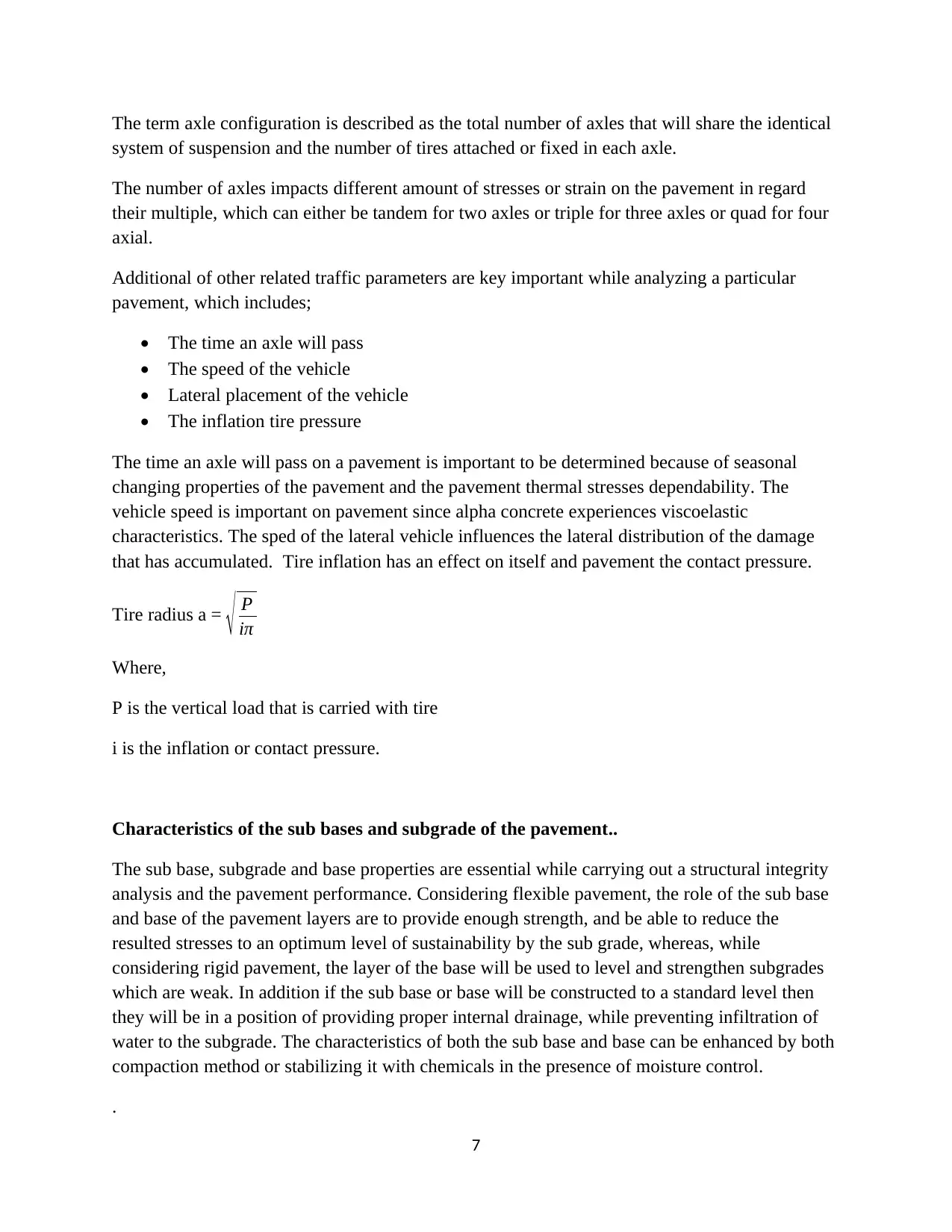
The term axle configuration is described as the total number of axles that will share the identical
system of suspension and the number of tires attached or fixed in each axle.
The number of axles impacts different amount of stresses or strain on the pavement in regard
their multiple, which can either be tandem for two axles or triple for three axles or quad for four
axial.
Additional of other related traffic parameters are key important while analyzing a particular
pavement, which includes;
• The time an axle will pass
• The speed of the vehicle
• Lateral placement of the vehicle
• The inflation tire pressure
The time an axle will pass on a pavement is important to be determined because of seasonal
changing properties of the pavement and the pavement thermal stresses dependability. The
vehicle speed is important on pavement since alpha concrete experiences viscoelastic
characteristics. The sped of the lateral vehicle influences the lateral distribution of the damage
that has accumulated. Tire inflation has an effect on itself and pavement the contact pressure.
Tire radius a = √ P
iπ
Where,
P is the vertical load that is carried with tire
i is the inflation or contact pressure.
Characteristics of the sub bases and subgrade of the pavement..
The sub base, subgrade and base properties are essential while carrying out a structural integrity
analysis and the pavement performance. Considering flexible pavement, the role of the sub base
and base of the pavement layers are to provide enough strength, and be able to reduce the
resulted stresses to an optimum level of sustainability by the sub grade, whereas, while
considering rigid pavement, the layer of the base will be used to level and strengthen subgrades
which are weak. In addition if the sub base or base will be constructed to a standard level then
they will be in a position of providing proper internal drainage, while preventing infiltration of
water to the subgrade. The characteristics of both the sub base and base can be enhanced by both
compaction method or stabilizing it with chemicals in the presence of moisture control.
.
7
system of suspension and the number of tires attached or fixed in each axle.
The number of axles impacts different amount of stresses or strain on the pavement in regard
their multiple, which can either be tandem for two axles or triple for three axles or quad for four
axial.
Additional of other related traffic parameters are key important while analyzing a particular
pavement, which includes;
• The time an axle will pass
• The speed of the vehicle
• Lateral placement of the vehicle
• The inflation tire pressure
The time an axle will pass on a pavement is important to be determined because of seasonal
changing properties of the pavement and the pavement thermal stresses dependability. The
vehicle speed is important on pavement since alpha concrete experiences viscoelastic
characteristics. The sped of the lateral vehicle influences the lateral distribution of the damage
that has accumulated. Tire inflation has an effect on itself and pavement the contact pressure.
Tire radius a = √ P
iπ
Where,
P is the vertical load that is carried with tire
i is the inflation or contact pressure.
Characteristics of the sub bases and subgrade of the pavement..
The sub base, subgrade and base properties are essential while carrying out a structural integrity
analysis and the pavement performance. Considering flexible pavement, the role of the sub base
and base of the pavement layers are to provide enough strength, and be able to reduce the
resulted stresses to an optimum level of sustainability by the sub grade, whereas, while
considering rigid pavement, the layer of the base will be used to level and strengthen subgrades
which are weak. In addition if the sub base or base will be constructed to a standard level then
they will be in a position of providing proper internal drainage, while preventing infiltration of
water to the subgrade. The characteristics of both the sub base and base can be enhanced by both
compaction method or stabilizing it with chemicals in the presence of moisture control.
.
7
Paraphrase This Document
Need a fresh take? Get an instant paraphrase of this document with our AI Paraphraser
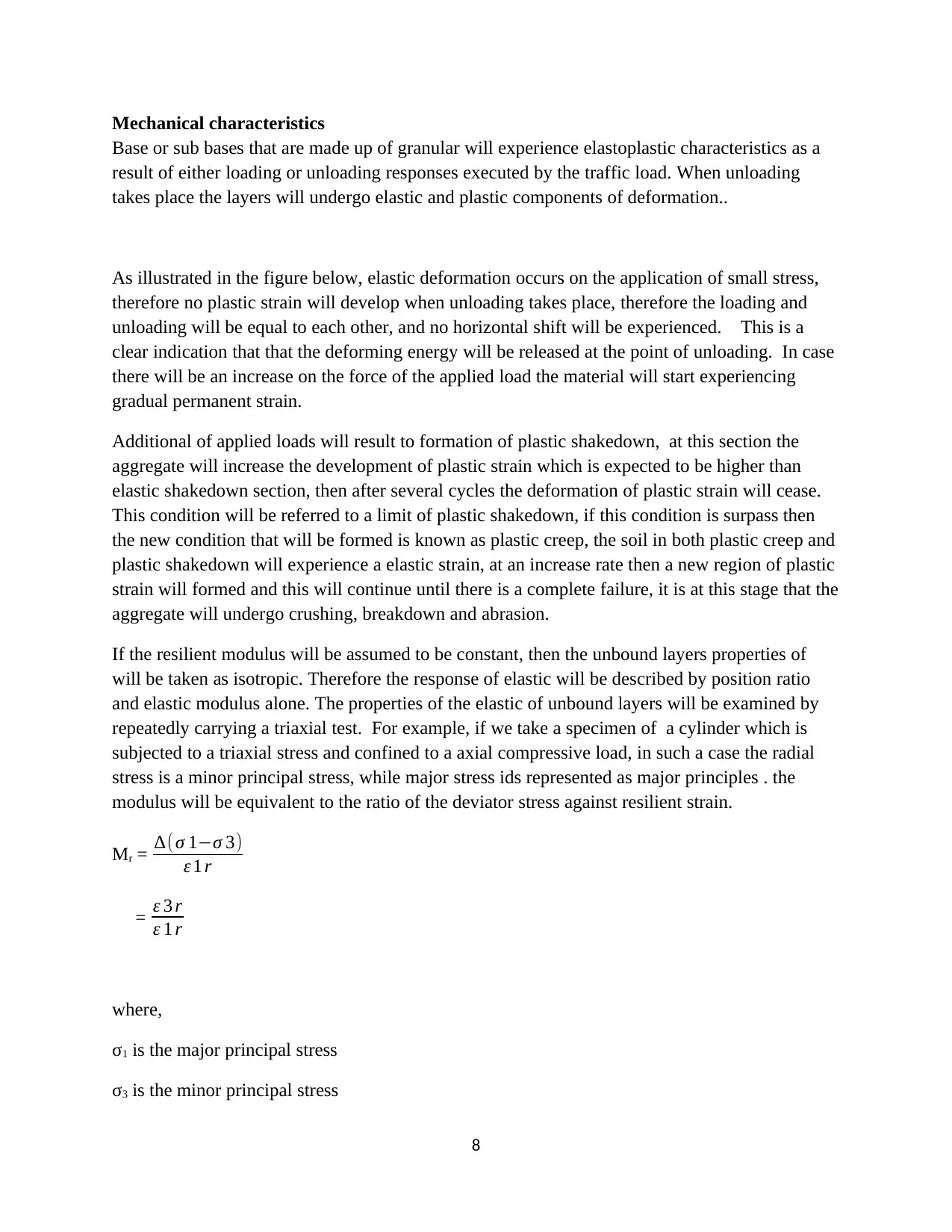
Mechanical characteristics
Base or sub bases that are made up of granular will experience elastoplastic characteristics as a
result of either loading or unloading responses executed by the traffic load. When unloading
takes place the layers will undergo elastic and plastic components of deformation..
As illustrated in the figure below, elastic deformation occurs on the application of small stress,
therefore no plastic strain will develop when unloading takes place, therefore the loading and
unloading will be equal to each other, and no horizontal shift will be experienced. This is a
clear indication that that the deforming energy will be released at the point of unloading. In case
there will be an increase on the force of the applied load the material will start experiencing
gradual permanent strain.
Additional of applied loads will result to formation of plastic shakedown, at this section the
aggregate will increase the development of plastic strain which is expected to be higher than
elastic shakedown section, then after several cycles the deformation of plastic strain will cease.
This condition will be referred to a limit of plastic shakedown, if this condition is surpass then
the new condition that will be formed is known as plastic creep, the soil in both plastic creep and
plastic shakedown will experience a elastic strain, at an increase rate then a new region of plastic
strain will formed and this will continue until there is a complete failure, it is at this stage that the
aggregate will undergo crushing, breakdown and abrasion.
If the resilient modulus will be assumed to be constant, then the unbound layers properties of
will be taken as isotropic. Therefore the response of elastic will be described by position ratio
and elastic modulus alone. The properties of the elastic of unbound layers will be examined by
repeatedly carrying a triaxial test. For example, if we take a specimen of a cylinder which is
subjected to a triaxial stress and confined to a axial compressive load, in such a case the radial
stress is a minor principal stress, while major stress ids represented as major principles . the
modulus will be equivalent to the ratio of the deviator stress against resilient strain.
Mr = ∆(σ 1−σ 3)
ε 1 r
= ε 3 r
ε 1 r
where,
σ1 is the major principal stress
σ3 is the minor principal stress
8
Base or sub bases that are made up of granular will experience elastoplastic characteristics as a
result of either loading or unloading responses executed by the traffic load. When unloading
takes place the layers will undergo elastic and plastic components of deformation..
As illustrated in the figure below, elastic deformation occurs on the application of small stress,
therefore no plastic strain will develop when unloading takes place, therefore the loading and
unloading will be equal to each other, and no horizontal shift will be experienced. This is a
clear indication that that the deforming energy will be released at the point of unloading. In case
there will be an increase on the force of the applied load the material will start experiencing
gradual permanent strain.
Additional of applied loads will result to formation of plastic shakedown, at this section the
aggregate will increase the development of plastic strain which is expected to be higher than
elastic shakedown section, then after several cycles the deformation of plastic strain will cease.
This condition will be referred to a limit of plastic shakedown, if this condition is surpass then
the new condition that will be formed is known as plastic creep, the soil in both plastic creep and
plastic shakedown will experience a elastic strain, at an increase rate then a new region of plastic
strain will formed and this will continue until there is a complete failure, it is at this stage that the
aggregate will undergo crushing, breakdown and abrasion.
If the resilient modulus will be assumed to be constant, then the unbound layers properties of
will be taken as isotropic. Therefore the response of elastic will be described by position ratio
and elastic modulus alone. The properties of the elastic of unbound layers will be examined by
repeatedly carrying a triaxial test. For example, if we take a specimen of a cylinder which is
subjected to a triaxial stress and confined to a axial compressive load, in such a case the radial
stress is a minor principal stress, while major stress ids represented as major principles . the
modulus will be equivalent to the ratio of the deviator stress against resilient strain.
Mr = ∆(σ 1−σ 3)
ε 1 r
= ε 3 r
ε 1 r
where,
σ1 is the major principal stress
σ3 is the minor principal stress
8
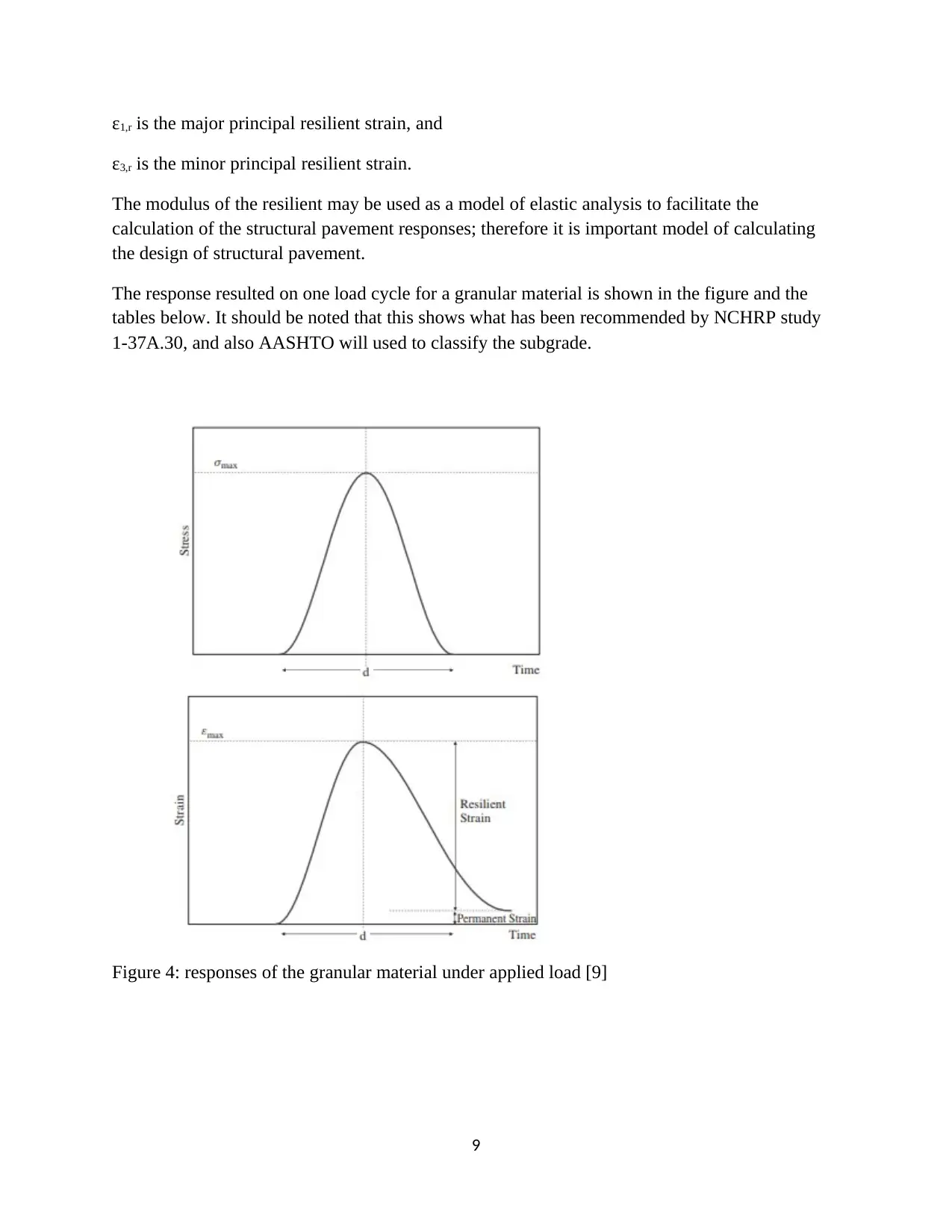
ε1,r is the major principal resilient strain, and
ε3,r is the minor principal resilient strain.
The modulus of the resilient may be used as a model of elastic analysis to facilitate the
calculation of the structural pavement responses; therefore it is important model of calculating
the design of structural pavement.
The response resulted on one load cycle for a granular material is shown in the figure and the
tables below. It should be noted that this shows what has been recommended by NCHRP study
1-37A.30, and also AASHTO will used to classify the subgrade.
Figure 4: responses of the granular material under applied load [9]
9
ε3,r is the minor principal resilient strain.
The modulus of the resilient may be used as a model of elastic analysis to facilitate the
calculation of the structural pavement responses; therefore it is important model of calculating
the design of structural pavement.
The response resulted on one load cycle for a granular material is shown in the figure and the
tables below. It should be noted that this shows what has been recommended by NCHRP study
1-37A.30, and also AASHTO will used to classify the subgrade.
Figure 4: responses of the granular material under applied load [9]
9
⊘ This is a preview!⊘
Do you want full access?
Subscribe today to unlock all pages.

Trusted by 1+ million students worldwide
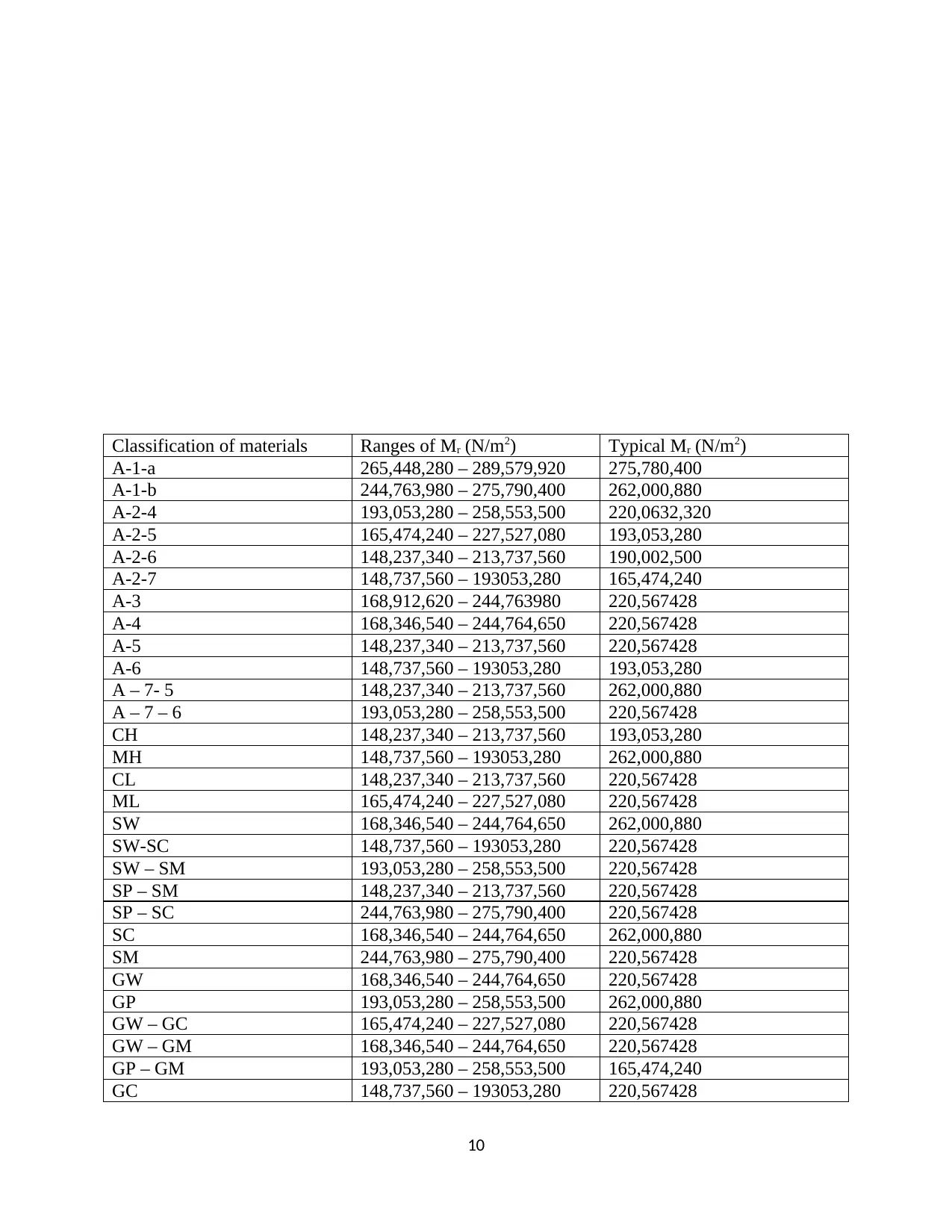
Classification of materials Ranges of Mr (N/m2) Typical Mr (N/m2)
A-1-a 265,448,280 – 289,579,920 275,780,400
A-1-b 244,763,980 – 275,790,400 262,000,880
A-2-4 193,053,280 – 258,553,500 220,0632,320
A-2-5 165,474,240 – 227,527,080 193,053,280
A-2-6 148,237,340 – 213,737,560 190,002,500
A-2-7 148,737,560 – 193053,280 165,474,240
A-3 168,912,620 – 244,763980 220,567428
A-4 168,346,540 – 244,764,650 220,567428
A-5 148,237,340 – 213,737,560 220,567428
A-6 148,737,560 – 193053,280 193,053,280
A – 7- 5 148,237,340 – 213,737,560 262,000,880
A – 7 – 6 193,053,280 – 258,553,500 220,567428
CH 148,237,340 – 213,737,560 193,053,280
MH 148,737,560 – 193053,280 262,000,880
CL 148,237,340 – 213,737,560 220,567428
ML 165,474,240 – 227,527,080 220,567428
SW 168,346,540 – 244,764,650 262,000,880
SW-SC 148,737,560 – 193053,280 220,567428
SW – SM 193,053,280 – 258,553,500 220,567428
SP – SM 148,237,340 – 213,737,560 220,567428
SP – SC 244,763,980 – 275,790,400 220,567428
SC 168,346,540 – 244,764,650 262,000,880
SM 244,763,980 – 275,790,400 220,567428
GW 168,346,540 – 244,764,650 220,567428
GP 193,053,280 – 258,553,500 262,000,880
GW – GC 165,474,240 – 227,527,080 220,567428
GW – GM 168,346,540 – 244,764,650 220,567428
GP – GM 193,053,280 – 258,553,500 165,474,240
GC 148,737,560 – 193053,280 220,567428
10
A-1-a 265,448,280 – 289,579,920 275,780,400
A-1-b 244,763,980 – 275,790,400 262,000,880
A-2-4 193,053,280 – 258,553,500 220,0632,320
A-2-5 165,474,240 – 227,527,080 193,053,280
A-2-6 148,237,340 – 213,737,560 190,002,500
A-2-7 148,737,560 – 193053,280 165,474,240
A-3 168,912,620 – 244,763980 220,567428
A-4 168,346,540 – 244,764,650 220,567428
A-5 148,237,340 – 213,737,560 220,567428
A-6 148,737,560 – 193053,280 193,053,280
A – 7- 5 148,237,340 – 213,737,560 262,000,880
A – 7 – 6 193,053,280 – 258,553,500 220,567428
CH 148,237,340 – 213,737,560 193,053,280
MH 148,737,560 – 193053,280 262,000,880
CL 148,237,340 – 213,737,560 220,567428
ML 165,474,240 – 227,527,080 220,567428
SW 168,346,540 – 244,764,650 262,000,880
SW-SC 148,737,560 – 193053,280 220,567428
SW – SM 193,053,280 – 258,553,500 220,567428
SP – SM 148,237,340 – 213,737,560 220,567428
SP – SC 244,763,980 – 275,790,400 220,567428
SC 168,346,540 – 244,764,650 262,000,880
SM 244,763,980 – 275,790,400 220,567428
GW 168,346,540 – 244,764,650 220,567428
GP 193,053,280 – 258,553,500 262,000,880
GW – GC 165,474,240 – 227,527,080 220,567428
GW – GM 168,346,540 – 244,764,650 220,567428
GP – GM 193,053,280 – 258,553,500 165,474,240
GC 148,737,560 – 193053,280 220,567428
10
Paraphrase This Document
Need a fresh take? Get an instant paraphrase of this document with our AI Paraphraser
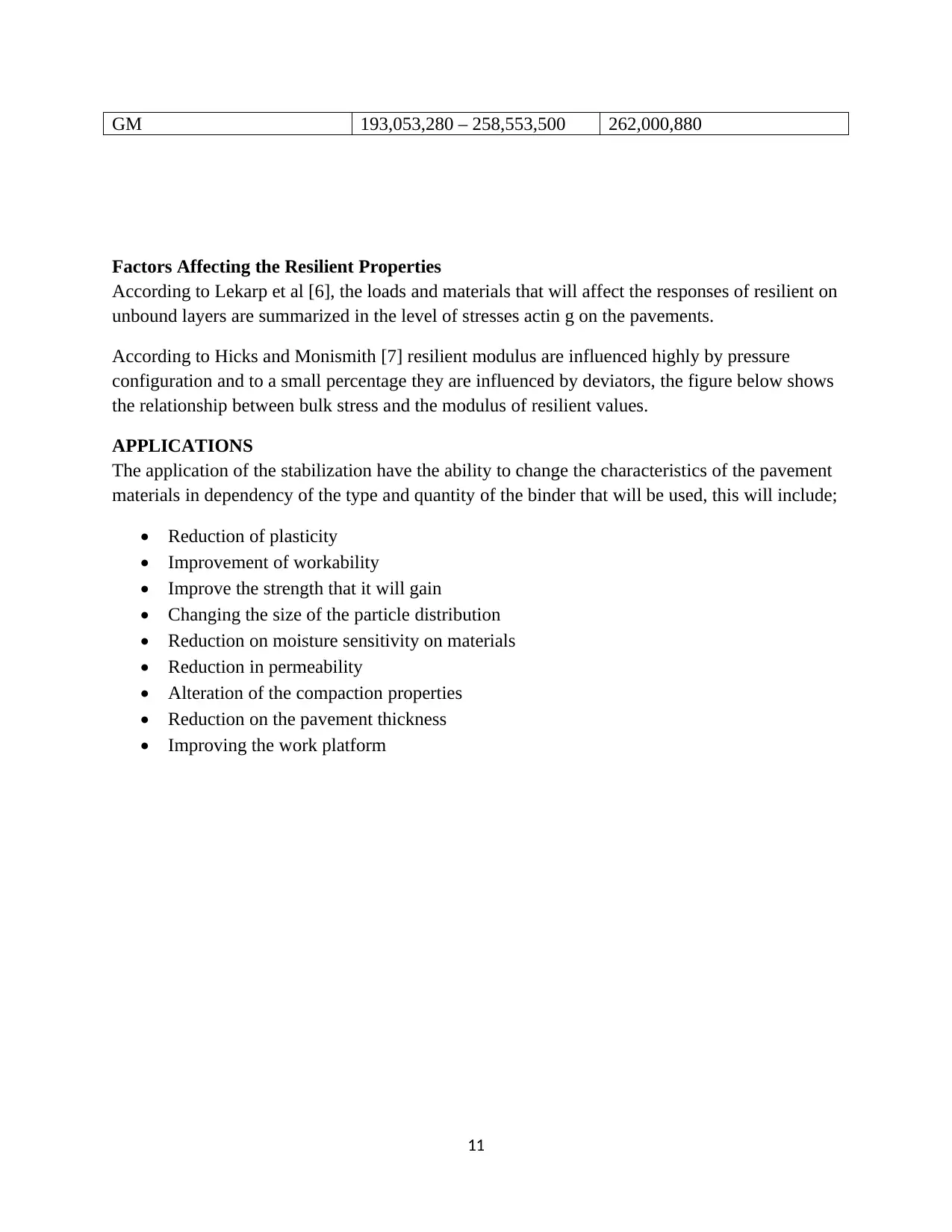
GM 193,053,280 – 258,553,500 262,000,880
Factors Affecting the Resilient Properties
According to Lekarp et al [6], the loads and materials that will affect the responses of resilient on
unbound layers are summarized in the level of stresses actin g on the pavements.
According to Hicks and Monismith [7] resilient modulus are influenced highly by pressure
configuration and to a small percentage they are influenced by deviators, the figure below shows
the relationship between bulk stress and the modulus of resilient values.
APPLICATIONS
The application of the stabilization have the ability to change the characteristics of the pavement
materials in dependency of the type and quantity of the binder that will be used, this will include;
• Reduction of plasticity
• Improvement of workability
• Improve the strength that it will gain
• Changing the size of the particle distribution
• Reduction on moisture sensitivity on materials
• Reduction in permeability
• Alteration of the compaction properties
• Reduction on the pavement thickness
• Improving the work platform
11
Factors Affecting the Resilient Properties
According to Lekarp et al [6], the loads and materials that will affect the responses of resilient on
unbound layers are summarized in the level of stresses actin g on the pavements.
According to Hicks and Monismith [7] resilient modulus are influenced highly by pressure
configuration and to a small percentage they are influenced by deviators, the figure below shows
the relationship between bulk stress and the modulus of resilient values.
APPLICATIONS
The application of the stabilization have the ability to change the characteristics of the pavement
materials in dependency of the type and quantity of the binder that will be used, this will include;
• Reduction of plasticity
• Improvement of workability
• Improve the strength that it will gain
• Changing the size of the particle distribution
• Reduction on moisture sensitivity on materials
• Reduction in permeability
• Alteration of the compaction properties
• Reduction on the pavement thickness
• Improving the work platform
11
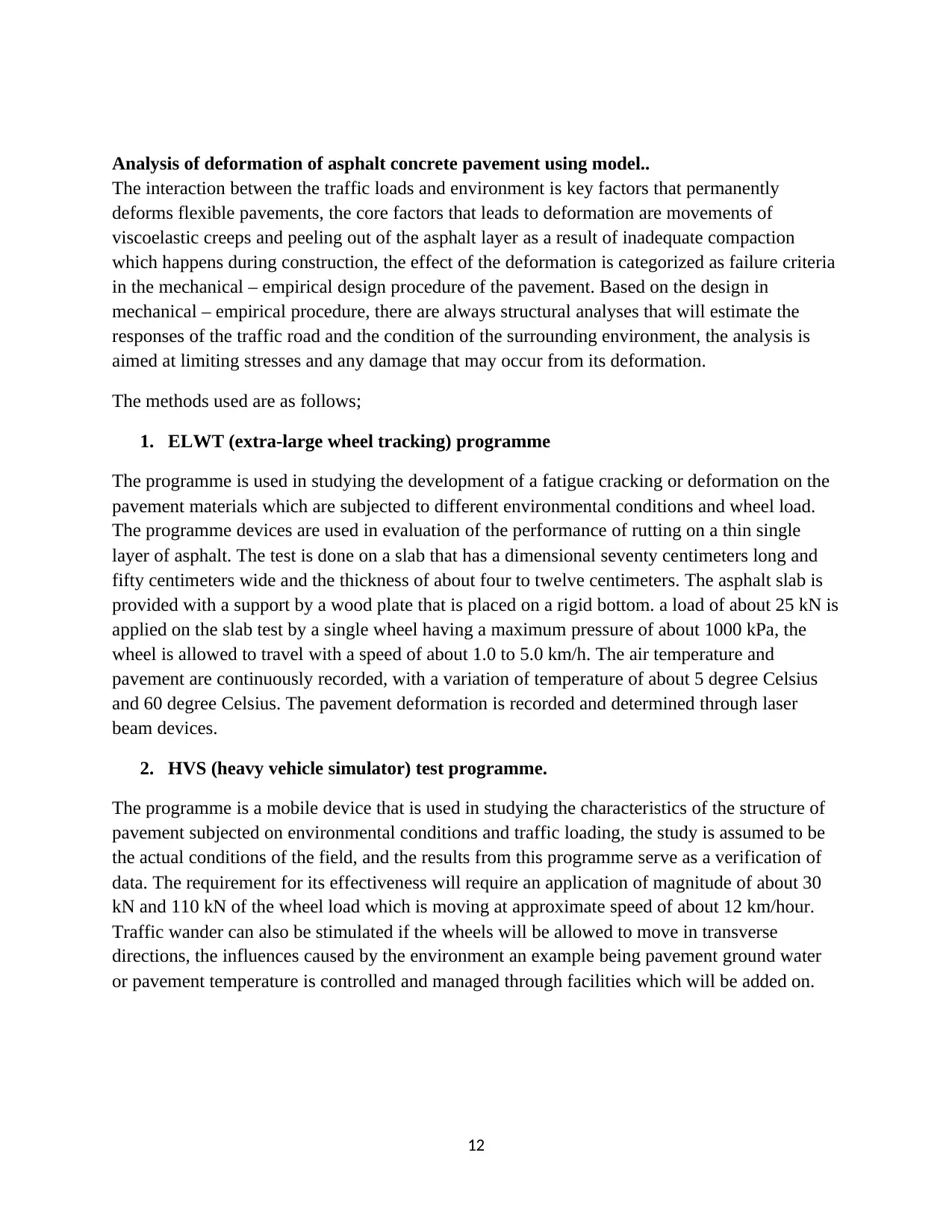
Analysis of deformation of asphalt concrete pavement using model..
The interaction between the traffic loads and environment is key factors that permanently
deforms flexible pavements, the core factors that leads to deformation are movements of
viscoelastic creeps and peeling out of the asphalt layer as a result of inadequate compaction
which happens during construction, the effect of the deformation is categorized as failure criteria
in the mechanical – empirical design procedure of the pavement. Based on the design in
mechanical – empirical procedure, there are always structural analyses that will estimate the
responses of the traffic road and the condition of the surrounding environment, the analysis is
aimed at limiting stresses and any damage that may occur from its deformation.
The methods used are as follows;
1. ELWT (extra-large wheel tracking) programme
The programme is used in studying the development of a fatigue cracking or deformation on the
pavement materials which are subjected to different environmental conditions and wheel load.
The programme devices are used in evaluation of the performance of rutting on a thin single
layer of asphalt. The test is done on a slab that has a dimensional seventy centimeters long and
fifty centimeters wide and the thickness of about four to twelve centimeters. The asphalt slab is
provided with a support by a wood plate that is placed on a rigid bottom. a load of about 25 kN is
applied on the slab test by a single wheel having a maximum pressure of about 1000 kPa, the
wheel is allowed to travel with a speed of about 1.0 to 5.0 km/h. The air temperature and
pavement are continuously recorded, with a variation of temperature of about 5 degree Celsius
and 60 degree Celsius. The pavement deformation is recorded and determined through laser
beam devices.
2. HVS (heavy vehicle simulator) test programme.
The programme is a mobile device that is used in studying the characteristics of the structure of
pavement subjected on environmental conditions and traffic loading, the study is assumed to be
the actual conditions of the field, and the results from this programme serve as a verification of
data. The requirement for its effectiveness will require an application of magnitude of about 30
kN and 110 kN of the wheel load which is moving at approximate speed of about 12 km/hour.
Traffic wander can also be stimulated if the wheels will be allowed to move in transverse
directions, the influences caused by the environment an example being pavement ground water
or pavement temperature is controlled and managed through facilities which will be added on.
12
The interaction between the traffic loads and environment is key factors that permanently
deforms flexible pavements, the core factors that leads to deformation are movements of
viscoelastic creeps and peeling out of the asphalt layer as a result of inadequate compaction
which happens during construction, the effect of the deformation is categorized as failure criteria
in the mechanical – empirical design procedure of the pavement. Based on the design in
mechanical – empirical procedure, there are always structural analyses that will estimate the
responses of the traffic road and the condition of the surrounding environment, the analysis is
aimed at limiting stresses and any damage that may occur from its deformation.
The methods used are as follows;
1. ELWT (extra-large wheel tracking) programme
The programme is used in studying the development of a fatigue cracking or deformation on the
pavement materials which are subjected to different environmental conditions and wheel load.
The programme devices are used in evaluation of the performance of rutting on a thin single
layer of asphalt. The test is done on a slab that has a dimensional seventy centimeters long and
fifty centimeters wide and the thickness of about four to twelve centimeters. The asphalt slab is
provided with a support by a wood plate that is placed on a rigid bottom. a load of about 25 kN is
applied on the slab test by a single wheel having a maximum pressure of about 1000 kPa, the
wheel is allowed to travel with a speed of about 1.0 to 5.0 km/h. The air temperature and
pavement are continuously recorded, with a variation of temperature of about 5 degree Celsius
and 60 degree Celsius. The pavement deformation is recorded and determined through laser
beam devices.
2. HVS (heavy vehicle simulator) test programme.
The programme is a mobile device that is used in studying the characteristics of the structure of
pavement subjected on environmental conditions and traffic loading, the study is assumed to be
the actual conditions of the field, and the results from this programme serve as a verification of
data. The requirement for its effectiveness will require an application of magnitude of about 30
kN and 110 kN of the wheel load which is moving at approximate speed of about 12 km/hour.
Traffic wander can also be stimulated if the wheels will be allowed to move in transverse
directions, the influences caused by the environment an example being pavement ground water
or pavement temperature is controlled and managed through facilities which will be added on.
12
⊘ This is a preview!⊘
Do you want full access?
Subscribe today to unlock all pages.

Trusted by 1+ million students worldwide
1 out of 23
Your All-in-One AI-Powered Toolkit for Academic Success.
+13062052269
info@desklib.com
Available 24*7 on WhatsApp / Email
![[object Object]](/_next/static/media/star-bottom.7253800d.svg)
Unlock your academic potential
Copyright © 2020–2025 A2Z Services. All Rights Reserved. Developed and managed by ZUCOL.
